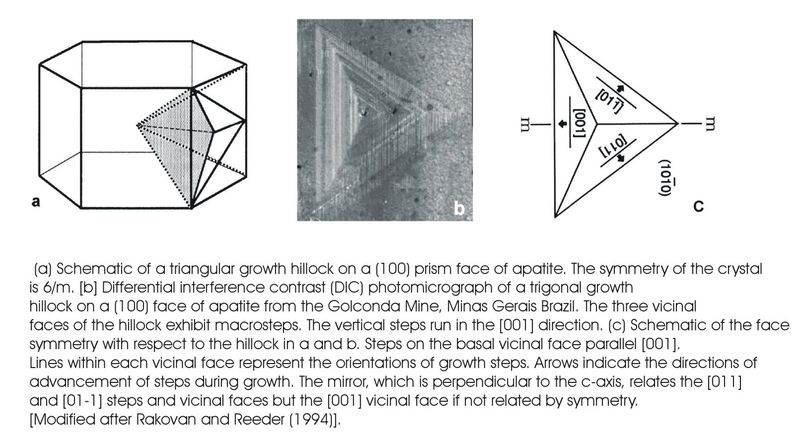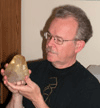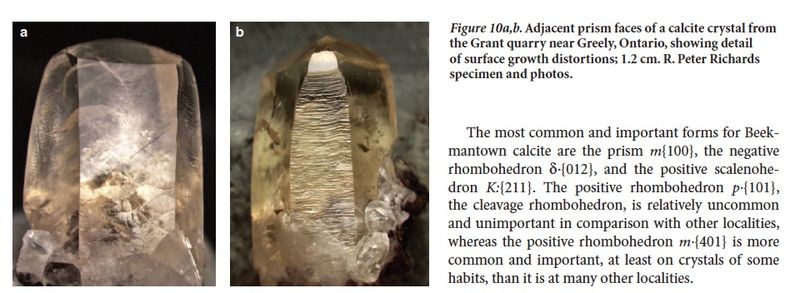| View previous topic :: View next topic |
| Author |
Message |
Matt_Zukowski
Site Admin
Joined: 10 Apr 2009
Posts: 737
Location: Alaska



|
 Posted: May 06, 2014 22:01 Post subject: Puzzled by triangular hillocks on apatite prism faces Posted: May 06, 2014 22:01 Post subject: Puzzled by triangular hillocks on apatite prism faces |
|
|
I the first chapter of Apatite-The Great Pretender (Lithographie No. 7), on page 9, Rakovan and Hughes describe triangular growth hillocks on the prism faces of apatite.
My understanding was that prism faces of (most?) hexagonal minerals display 2-fold symmetry and that this is why the growth and etch features on beryl prism faces are rectangular. Is this wrong? Doesn't apatite also show the same 2-fold symmetry through the prism faces? Is there something unique about the way the apatite structure intersects the prism faces that causes this?
I looked online for the reference (Rakovan 2002) but could not find it to read more.
Thanks.
|
|
| Back to top |
|
 |
John Rakovan
Joined: 25 Mar 2014
Posts: 12
Location: Bureau of Geology and Mineral Resources, New Mexico Institute of Mining and Technology


|
 Posted: May 07, 2014 06:11 Post subject: Re: Puzzled by triangular hillocks on apatite prism faces Posted: May 07, 2014 06:11 Post subject: Re: Puzzled by triangular hillocks on apatite prism faces |
|
|
Hi Matt,
The triangular growth hillocks on the {100} crystal faces are made up of three vicinal faces with steps that are oriented in different directions, [001], [011] and [01-1]. See the attached figure. The answer to why steps on the {100} take the orientations that they do is a bit involved but it can be understood through a concept called Hartman-Perdok Theory.
As for the relationship of the hillocks to symmetry, you are correct that they are constrained to follow the symmetry of the (100) face. The point group symmetry of apatite is 6/m; a six-fold axis of rotation oriented parallel to the c crystallographic axis and a mirror plane perpendicular to the c-axis . Thus, the only symmetry in the (100) of apatite is a mirror plane. There is no 2-fold symmetry as in beryl. That being said, etch pits on the (100) of apatite often exhibit pseudo 2-fold symmetry as well as mirror symmetry. Anyway, the shape of the triangular hillocks is constrained by the mirror, and two vicinal faces of the hillock, [011] and [01-1] are related by the mirror. The [001] vicinal face is not related by symmetry to the other two. This by the way can lead to beautiful examples of intrasectoral zoning in apatite.
Cheers
John
| Matt_Zukowski wrote: | I the first chapter of Apatite-The Great Pretender (Lithographie No. 7), on page 9, Rankovan and Hughes describe triangular growth hillocks on the prism faces of apatite.
My understanding was that prism faces of (most?) hexagonal minerals display 2-fold symmetry and that this is why the growth and etch features on beryl prism faces are rectangular. Is this wrong? Doesn't apatite also show the same 2-fold symmetry through the prism faces? Is there something unique about the way the apatite structure intersects the prism faces that causes this?
I looked online for the reference (Rakovan 2002) but could not find it to read more.
Thanks. |
| Description: |
|
| Viewed: |
12518 Time(s) |

|
|
|
| Back to top |
|
 |
Matt_Zukowski
Site Admin
Joined: 10 Apr 2009
Posts: 737
Location: Alaska



|
 Posted: May 07, 2014 08:48 Post subject: Re: Puzzled by triangular hillocks on apatite prism faces Posted: May 07, 2014 08:48 Post subject: Re: Puzzled by triangular hillocks on apatite prism faces |
|
|
| Wow...interesting...and thanks for the quick reply. I need to expand my understanding of hexagonal minerals to take in the range of point groups. I certainly see how the triangular growth features obey the mirror plane, and thus the symmetry.
|
|
| Back to top |
|
 |
Gerhard Niklasch
Joined: 27 Mar 2009
Posts: 134
Location: Munich



|
 Posted: May 07, 2014 09:11 Post subject: Re: Puzzled by triangular hillocks on apatite prism faces Posted: May 07, 2014 09:11 Post subject: Re: Puzzled by triangular hillocks on apatite prism faces |
|
|
A somewhat related observation:
While Quartz has 2-fold rotations which exchange the two ends of the c axis, its 'm' prism faces have no such 2-fold symmetry individually. (In an ideal crystal, the 2-fold axes pass through the edges between adjacent prism faces.)
And indeed there's sometimes a noticeable difference in surface texture (striations, hills, pits…) between the two ends of one and the same 'm' face, the one adjacent to an 'r' pyramid face and the one adjacent to 'z' - and when enough of the crystal is visible, you can see these features alternating in orientation as you move around the prism.
Enjoy,
Gerhard
|
|
| Back to top |
|
 |
John Rakovan
Joined: 25 Mar 2014
Posts: 12
Location: Bureau of Geology and Mineral Resources, New Mexico Institute of Mining and Technology


|
 Posted: May 07, 2014 10:14 Post subject: Re: Puzzled by triangular hillocks on apatite prism faces Posted: May 07, 2014 10:14 Post subject: Re: Puzzled by triangular hillocks on apatite prism faces |
|
|
Matt,
If you are interested in diving into Hartman & Perdok theory and periodic bond chains in apatite I suggest the following papers. I tried copying both references into google and found copies of each available online.
Hartman, P. and Perdok, W.G. (1953) On the relations between structure and morphology of crystals I. Acta Crystallogrphica, 8, 49 52.
Terpstra, R.A., Bennema, P., Hartman, P., Woensdregt, C.F., Perdok, W.G., and Senechal, M.L. (1986) F faces of apatite and its morphology: Theory and observation. Journal of Crystal Growth, 78, 468 478.
Cheers,
John
|
|
| Back to top |
|
 |
Pete Richards
Site Admin

Joined: 29 Dec 2008
Posts: 846
Location: Northeast Ohio



|
 Posted: May 07, 2014 10:15 Post subject: Re: Puzzled by triangular hillocks on apatite prism faces Posted: May 07, 2014 10:15 Post subject: Re: Puzzled by triangular hillocks on apatite prism faces |
|
|
| Gerhard Niklasch wrote: | A somewhat related observation:
While Quartz has 2-fold rotations which exchange the two ends of the c axis, its 'm' prism faces have no such 2-fold symmetry individually. (In an ideal crystal, the 2-fold axes pass through the edges between adjacent prism faces.)
And indeed there's sometimes a noticeable difference in surface texture (striations, hills, pits…) between the two ends of one and the same 'm' face, the one adjacent to an 'r' pyramid face and the one adjacent to 'z' - and when enough of the crystal is visible, you can see these features alternating in orientation as you move around the prism.
Enjoy,
Gerhard |
The same is true of calcite. The images below show opposite ends of the (10.0) prism faces. A description I wrote for a Rocks and Minerals article follows:
The prism faces actually observed on these crystals taper
inward very slightly at one end and more strongly at the
other end. Near the strongly tapered end of each face is a
high point. The part of the face between the high point and
the strongly tapered end is characteristically smooth and
rounded, like a gentle hill. In some crystals there is a gently
rounded ridge running from the high point to the middle of
the near end. The other end of each prism face is almost filelike,
or scaly, and is composed of alternating facets belonging
to at least three different crystal forms including m·{401}
(see below). These characteristic distortions oscillate from
prism face to prism face around the crystal, pointing
first up, then down. All of these distortions are
regular and consistent from crystal to crystal, even
though most of them are not composed of crystallographically
identifiable faces. Their arrangement
around the crystal is consistent with the symmetry
of calcite. This distortion is not accidental but reflects
the nucleation and propagation of new layers
of atoms on the crystal (and possibly dissolution at
the smooth end). The distortion may reflect crystal
growth in a “dirty” environment that prevented
the layers from spreading across the entire face and
forming a smooth, flat surface, or it may indicate an
incipient change in habit that was not completed.
| Description: |
|
| Viewed: |
12423 Time(s) |

|
_________________
Collecting and studying crystals with interesting habits, twinning, and epitaxy |
|
| Back to top |
|
 |
Peter
Joined: 16 Jan 2009
Posts: 346
Location: Sweden / Luxembourg


|
 Posted: May 08, 2014 11:22 Post subject: Re: Puzzled by triangular hillocks on apatite prism faces Posted: May 08, 2014 11:22 Post subject: Re: Puzzled by triangular hillocks on apatite prism faces |
|
|
Thank you gentlemen for your insight and for sharing
Peter
|
|
| Back to top |
|
 |
|




